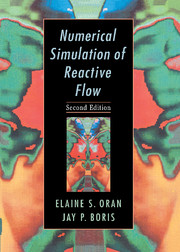Book contents
- Frontmatter
- Contents
- Prologue
- 1 An Overview of Numerical Simulation
- 2 The Reactive-Flow Modeling Problem
- 3 Models and Simulation
- 4 Some General Numerical Considerations
- 5 Ordinary Differential Equations: Reaction Mechanisms and Other Local Phenomena
- 6 Representations, Resolution, and Grids
- 7 Diffusive Transport Processes
- 8 Computational Fluid Dynamics: Continuity Equations
- 9 Computational Fluid Dynamics: Using More Flow Physics
- 10 Boundaries, Interfaces, and Implicit Algorithms
- 11 Coupling Models of Reactive-Flow Processes
- 12 Turbulent Reactive Flows
- 13 Radiation Transport and Reactive Flows
- Index
1 - An Overview of Numerical Simulation
Published online by Cambridge University Press: 09 October 2009
- Frontmatter
- Contents
- Prologue
- 1 An Overview of Numerical Simulation
- 2 The Reactive-Flow Modeling Problem
- 3 Models and Simulation
- 4 Some General Numerical Considerations
- 5 Ordinary Differential Equations: Reaction Mechanisms and Other Local Phenomena
- 6 Representations, Resolution, and Grids
- 7 Diffusive Transport Processes
- 8 Computational Fluid Dynamics: Continuity Equations
- 9 Computational Fluid Dynamics: Using More Flow Physics
- 10 Boundaries, Interfaces, and Implicit Algorithms
- 11 Coupling Models of Reactive-Flow Processes
- 12 Turbulent Reactive Flows
- 13 Radiation Transport and Reactive Flows
- Index
Summary
Reactive flows include a broad range of phenomena, such as flames, detonations, chemical lasers, the earth's atmosphere, stars and supernovae, and perhaps even the elementary particle interactions in the very early stages of the universe. There are striking physical differences among these flows, even though the general forms of the underlying equations are all quite similar. Therefore, considerations and procedures for constructing numerical models of these systems are also similar. The obvious and major differences are in the scales of the phenomena, the input data, the mathematical approximations that arise in representing different contributing physical processes, and the strength of the coupling among these processes.
For example, in flames and detonations, there is a close coupling among the chemical reactions, subsequent heat release, and the fluid dynamics, so that all of the processes must be considered simultaneously. In the earth's upper atmosphere, which is a weakly ionized plasma in a background neutral wind, the chemical reactions among ionized gases and the fluid dynamics are weakly coupled. These reactions take place in the background provided by the neutral gas motions. The sun's atmosphere is highly ionized, with reactions among photons, electrons, and ionized and neutral atomic species, all in the presence of strong electromagnetic fields. A Type Ia supernova creates the heavier elements in the periodic table through a series of strongly coupled thermonuclear reactions that occur in nuclear flames and detonations. The types of reactions, the major physical processes, and the degree and type of coupling among the processes vary substantially in these systems. Sometimes reactions are essentially decoupled from the fluid flow, sometimes radiation is important, and sometimes diffusive transport effects are important.
- Type
- Chapter
- Information
- Numerical Simulation of Reactive Flow , pp. 1 - 14Publisher: Cambridge University PressPrint publication year: 2000
- 1
- Cited by



